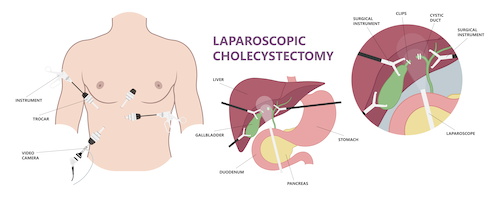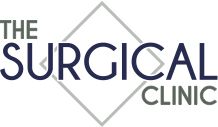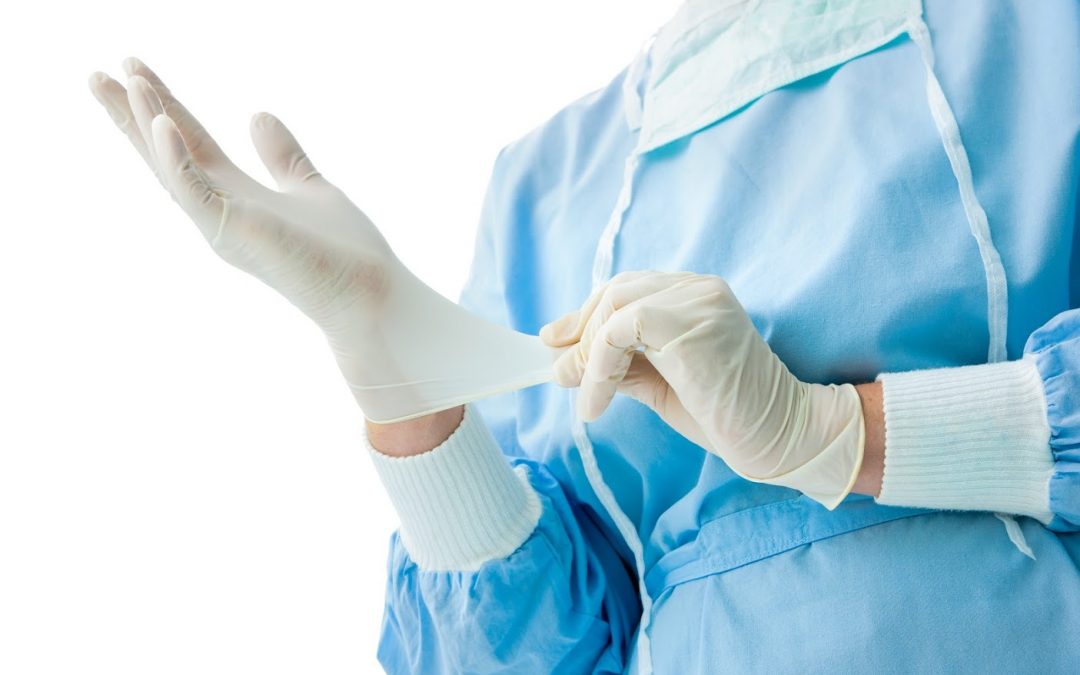Cholecystectomy, or surgical gallbladder removal, is a frequently performed procedure that can alleviate discomfort from gallstone pain without a lengthy hospital stay. Generally regarded as safe, this operation typically involves minimal risk of complications.
This procedure is commonly executed using minimally invasive techniques, such as laparoscopic or robotic surgery. These advanced methods utilize very small incisions, often half an inch or less, to reduce trauma, pain, and recovery time.
While the possibility of needing an open surgery with a larger incision exists, it’s relatively rare. The laparoscopic approach is far more prevalent today, further underscoring its status as a routine and less intrusive operation compared to traditional major surgeries.
In addition, minimally invasive laparoscopic (video-assisted) techniques have dramatically reduced surgical and healing timeframes. Remarkably, the majority of individuals can return home on the same day they have the procedure.
If you’re considering laparoscopic gallbladder removal, keep reading to learn what you need to know about recovering from this outpatient surgery.
What is a Gallbladder?
The gallbladder plays a vital role in the digestive system. It is a small, pear-shaped organ below the liver that stores bile; bile, a liquid produced by the liver.
Once you eat, the gallbladder releases bile into the small intestine to help break down fats, making them easier for the body to absorb and use. Essentially, the gallbladder acts as a storage unit that ensures bile is available when needed for digestion.
How does not having a gallbladder affect you?
While the gallbladder aids digestion, living without a gallbladder does not change your quality of life. There are typically no long-term effects to worry about after surgery. Though, you may need to make minor changes to your diet.
However, a small percentage of people might experience lingering symptoms, a condition referred to as post-cholecystectomy syndrome. This isn’t a single condition but rather a collection of symptoms that can vary widely.
Common symptoms include:
- Nausea
- Indigestion
- Acid reflux
- Gas and bloating
- Diarrhea
- Abdominal pain
- Jaundice
In most cases, patients that experience post-cholecystectomy syndrome only have a few of these symptoms, not all of them. These symptoms can arise from preexisting digestive diseases, gallstones, unexplained pain syndromes, surgical complications, or biliary dyskinesia.
Doctors usually address these symptoms and conditions on a case-by-case basis to ensure you receive personalized care. This approach helps manage any discomfort and maintains your quality of life post-surgery.
WHAT IS GALLBLADDER SURGERY?
The medical term for gallbladder surgery is cholecystectomy (KOL-i-si-STEK-tuh-mee).
A cholecystectomy, primarily performed to address gallstones, provides numerous benefits and promising results for those suffering from gallbladder issues.
One of the primary benefits is pain relief. Gallstones often cause significant discomfort, and conservative treatments, like dietary changes, typically cannot prevent these stones from recurring. In contrast, a cholecystectomy effectively eliminates this problem by removing the gallbladder, thereby preventing the return of gallstones for most patients.
Post-surgery, most individuals experience minimal digestive issues. While the gallbladder plays a role in digestion, it is not essential for healthy digestion overall. Though some people may encounter occasional loose stools after the procedure, this issue generally resolves itself over time.
Benefits of Cholecystectomy
A cholecystectomy offers notable benefits, including:
- relief from the pain associated with gallstones
- a lower risk of gallstone recurrence
- minimal digestive issues
- a relatively quick recovery period, particularly with the laparoscopic method
Always consult with your healthcare team to discuss any post-surgery symptoms or concerns.
WHAT DOES CHOLECYSTECTOMY MEAN?
Broken down, cholecystectomy means:
Chole = bile, Greek
Cysits = bladder, Latin
Ectomy = surgical removal, Greek
There are two primary methods for gallbladder removal: laparoscopic and open cholecystectomy.
Why Might a Colon Cleanse Be Necessary Before Gallbladder Surgery?
Undergoing gallbladder surgery requires meticulous preparation to ensure the procedure goes smoothly and to minimize potential complications. One crucial step in this preparation can be a colon cleanse. Here’s why it might be needed:
- Clear Surgical Field: A cleansed colon provides a better view for surgeons. This helps them avoid any bowel segments during the procedure, reducing the risk of injury.
- Reduced Infection Risk: Removing waste and bacteria from the colon lowers the chances of infections, which can benefit both during and after the surgery.
- Improved Recovery: A clean intestine can lead to a faster recovery. It aids in preventing post-operative complications such as bowel obstructions, which can be quite uncomfortable and delay healing.
- Facilitates Surgical Techniques: For minimally invasive techniques or laparoscopic procedures, a cleansed intestinal tract permits easier manipulation of surgical instruments, making the operation more efficient.
Preparation typically involves adhering to a diet of clear liquids. This step prepares the body by ensuring the intestines are free from solid waste, resulting in an operation with fewer complications.
Dietary Restrictions Before Gallbladder Surgery
Preparing for gallbladder surgery involves adhering to specific dietary restrictions to ensure a smooth procedure. Here’s what you need to know:
- Medications and Supplements: Discuss all medications, vitamins, and herbal supplements with your healthcare provider. Certain items may need to be paused before surgery to minimize risks.
- Blood Thinners: Refrain from taking blood thinning medications, such as aspirin, ibuprofen, and naproxen, at least one week before surgery. This also includes prescription blood thinners like Clopidogrel and warfarin.
- Dietary Supplements: Avoid using any diet pills or St. John’s Wort two weeks ahead of your scheduled surgery.
- Fasting Instructions: Do not consume food or drinks after midnight on the day before your surgery. This fasting period is crucial for reducing complications.
- Pre-Surgery Bowel Prep: Your surgeon may recommend a bowel preparation, which involves drinking only clear liquids for a specified period before surgery. Acceptable clear liquids include:
- Water
- Broth (chicken or beef)
- Fruit juices without pulp, such as apple or grape juice
- Herbal teas and regular teas without milk
- Black coffee (plain or sweetened)
- Gelatin desserts in non-red colors
- Popsicles and Italian ices without chunks of fruit or cream
By adhering to these dietary restrictions, you help ensure the best possible conditions for your upcoming surgery. Always follow your surgeon’s specific instructions for your situation.
What to Do on the Day of Gallbladder Surgery
Preparing for gallbladder surgery involves crucial steps to ensure everything goes smoothly. Here’s a comprehensive guide to what you should do on the day of your procedure:
- Midnight Fasting
Refrain from consuming any food or beverages starting at midnight before your surgery. This is vital to prevent complications during anesthesia. - Medication Guidelines
Certain medications may need to be taken even on the day of surgery. Take only those specified by your healthcare provider, accompanied by just a small sip of water to aid ingestion. - Arrival Instructions
Your medical team will provide specific instructions concerning what time to arrive at the healthcare facility. Ensure you follow their guidance closely to allow sufficient time for preparation and pre-surgery assessments.
Organizing and following these steps can help ease your anxiety and contribute to a successful surgical experience. Prepare any necessary documentation and personal belongings in advance to minimize morning stress.

GALLBLADDER REMOVAL AND POST-OP SURGICAL STAY
When it comes to gallbladder removal, or cholecystectomy, surgeons can choose between two main surgical techniques: laparoscopic cholecystectomy and open cholecystectomy. The choice of method often depends on the patient’s specific condition and medical history.
Open Cholecystectomy
A traditional open cholecystectomy procedure typically requires two to three days of post-operative hospital stay. This invasive, open procedure requires the surgeon to make a six-inch incision under the right side of the ribcage, moving the surrounding muscle and tissue to remove the gallbladder.
- Recovery: After gallbladder removal, the incision is sutured, and the patient is moved to a recovery area.
- Duration: Similar to the laparoscopic approach, this procedure also typically takes 1 to 2 hours.
Although more invasive, an open cholecystectomy may be necessary in cases where the laparoscopic method is not feasible, ensuring the patient’s safety and providing the surgeon better visibility and access.
After the surgery, your doctor may insert one or more drains into the incision to allow drainage of fluids or pus. They will likely remove the drains after a couple of days.
Laparoscopic Cholecystectomy
In comparison, a laparoscopic procedure is much less invasive. The surgeon makes four small incisions in the abdomen instead of one long cut. Then, the surgeon feeds a small video camera through one of the incisions, allowing the surgeon to view the interior of the abdomen on a monitor. Special surgical instruments are then inserted through the other incisions to carefully remove the gallbladder.
- Imaging Tests: If necessary, imaging tests like X-rays or ultrasounds may be conducted to inspect for gallstones or other complications in the bile duct.
- Duration: The procedure typically lasts between 1 to 2 hours.
Laparoscopic cholecystectomy is minimally invasive and generally has a shorter recovery time.
This less invasive approach often equals no hospital stay for most patients—meaning you can recover at home.
However, if the surgeon encounters complications, such as extensive scar tissue from previous surgeries, it may become necessary to switch to an open cholecystectomy.
Post-Gallbladder Surgery Care: Dressing Removal and Showering Guidelines
When to Remove Dressings: After gallbladder surgery, you can typically take off the dressings between 24 to 48 hours post-operation. It’s essential to ensure that the surgical site is clean and appears to be healing well before proceeding with removal. Always follow the specific guidance from your healthcare provider as individual cases may vary.
Resuming Showering: Once the dressings are safely removed, you can usually resume showering. This generally aligns with the 1-2 day timeline after surgery. Ensure that shower water is warm, not hot, and be gentle with the surgical area—avoid scrubbing.
Additional Tips:
- Monitor the Site: Keep an eye on the incision for signs of infection like redness, swelling, or unusual discharge.
- Pat Dry: After showering, gently pat the area dry with a clean towel instead of rubbing it.
- Call Your Doctor: If you have concerns or notice anything unusual, don’t hesitate to contact your healthcare provider for advice.
These guidelines aim to support your recovery process and help you get back to your routine comfortably and safely.
GALLBLADDER REMOVAL COST
Depending on your health insurance, laparoscopic gallbladder surgery can cost more than open surgery. The best way to determine the cost of the procedure is to consult your surgeon and discuss the best options.
Without insurance, gallbladder removal surgery can cost between $10,000 and $55,000. However, we gladly offer uninsured patients affordable payment options and financial assistance
EXPECTED PAIN
Post-surgical pain is a significant concern for many cholecystectomy patients. Even though every surgical procedure has some pain, the discomfort with gallbladder removal (especially when done laparoscopically) is typically minimal. The doctor may prescribe a pain medication or recommend that you take an over-the-counter pain medicine, such as acetaminophen or ibuprofen.
Some patients also experience shoulder pain following laparoscopic gallbladder removal surgery. This temporary discomfort comes from gas left in your abdomen during surgery.
Along with incision and shoulder pain, you may feel throat discomfort. This pain occurs because general anesthesia used during surgery requires a breathing tube. The placement and removal of the tube may irritate your throat in the day or days following the procedure.
Severe pain and cramping are not normal following laparoscopic cholecystectomy. If you experience these symptoms, call your doctor immediately.
RETURNING TO ACTIVITY AFTER GALLBLADDER REMOVAL
How soon can you resume your everyday activities after surgery? The answer to this question depends on your normal routine, overall health, and body’s reaction to the surgery. Don’t expect to resume a strenuous gym routine or return to a manual labor job immediately after your operation.
Recovery time can vary based on the surgical method used and the patient’s overall health.
Typically, open cholecystectomy takes 4-6 weeks to recover, while laparoscopic surgery takes about 1-2 weeks to recover. After recovery, the patient can resume regular activities, including work.
Immediate Post-Surgery Care
After surgery, you’ll spend a few hours in a recovery room while waking up from anesthesia. Pain medication will be available as needed, ensuring comfort as you begin the healing process.
If you had a laparoscopic cholecystectomy, you might be able to go home the same day. However, open cholecystectomy usually requires a few days of recovery in the hospital. In some cases, a drain may be placed and remain for a few days; occasionally you may even go home with it.
Even though laparoscopic surgery provides patients with a shorter healing time, you will still need to take it easy for several days after the procedure. Avoid heavy lifting and physical activity for the first week or two following your surgical discharge.
Most patients will feel better within seven days following surgery and can resume some normal activities, such as:
- Driving
- Walking
- Some duties at work
However, refrain from lifting, pushing, or pulling any heavy objects until you are cleared by your surgeon.
It’s possible, in some cases, to return to work or school during the first few weeks of your recovery period—especially if you sit at a desk or have a sedentary job. Your doctor will advise you when you can return to other activities, such as exercising or engaging in physically demanding tasks.
Again, this depends on your physical state and how your body reacts to the procedure. The doctor may want you to rest until your post-op follow-up visit. Your recovery is unique, so always follow your healthcare provider’s guidance to ensure a safe and effective healing process. According to the U.S. National Library of Medicine it may take up to six weeks for you to fully recover from the surgery.
At-Home Recovery Tips
Activity
- Rest whenever you feel tired. Getting enough sleep is essential for your body to recover.
- Gentle walking each day is encouraged. Start small and increase your distance gradually; walking not only boosts circulation but also helps prevent blood clots in your legs and reduces the risk of pneumonia.
- For about 2 to 4 weeks, steer clear of lifting anything that would cause you to strain—think hefty grocery bags, a full backpack, your favorite toddler, or even the vacuum cleaner.
- Avoid strenuous activities such as biking, jogging, weightlifting, and high-impact aerobics until your doctor gives you the green light.
- If you’re wondering when you can get back behind the wheel, ask your doctor for the go-ahead.
- Most people who have laparoscopic surgery can return to work or their normal routine in 1 to 2 weeks, but an open procedure may require 4 to 6 weeks before you’re back to your usual pace.
- Your surgeon will also let you know when it’s safe to resume sexual activity.
Diet
- When you feel ready to eat, start with small amounts and listen to your body.
- You may want to avoid greasy or fatty foods—fried fare and cheese, for example—for a while, as they can cause bloating or diarrhea.
- Stay hydrated by drinking plenty of fluids (unless your doctor has advised otherwise).
- It’s normal for your bowel movements to be a bit unpredictable following surgery. Try to avoid constipation and straining; a daily fiber supplement can help. If things haven’t returned to normal after a couple of days, ask your doctor about a gentle laxative.
Medication
- Your doctor will provide instructions on when to restart any regular medications and how to take any new prescriptions.
- If you paused blood thinners like aspirin, your doctor will advise you when to resume them.
- Always use medications safely—read the labels and follow directions.
- If you’ve been prescribed pain medication, take it exactly as directed.
- If you’re not on a prescription painkiller, ask if you can use an over-the-counter option.
- Avoid doubling up on pain medications, especially those containing acetaminophen (Tylenol), as too much can be harmful.
- If pain medication upsets your stomach, try taking it after meals (unless told otherwise), or ask your doctor about alternatives.
- If you’ve been prescribed antibiotics, finish the entire course—even if you’re feeling better halfway through.
Incision Care
- If surgical tape strips are holding your incision together, let them fall off naturally—this usually takes about a week.
- You can typically shower 24 to 48 hours post-surgery (if your doctor approves), but avoid soaking in a bath for the first two weeks.
- If you have staples, keep them dry until they’re removed—usually within 7 to 10 days.
- Keep the area clean and dry. Cover with gauze if it’s oozing or rubbing against clothing, and change the bandage daily.
Managing Swelling and Pain
- To help reduce swelling and discomfort, apply an ice pack or cold pack to your abdomen for 10 to 20 minutes at a time, every 1 to 2 hours. Always place a thin cloth between the ice and your skin.
Follow-Up Care
Staying on top of your follow-up appointments is crucial for your recovery. Reach out to your healthcare provider if you run into any problems, and keep a list of your current medications and test results handy for reference. Your path to recovery is personal—don’t hesitate to ask questions or seek support along the way.
EATING AFTER SURGERY
If you have had your gallbladder removed, you may be wondering about foods you can and cannot eat. Here are some tips for returning to your normal diet after surgery.
Start by gradually adding small amounts of low-fat foods to your diet. Eat plenty of fruits, vegetables, and lean protein sources such as chicken or fish.
Avoid high-fat foods, fried foods, and foods high in sugar. After surgery, your fat calories should be no more than 30% of your diet. Instead, slowly incorporate high-fiber foods as you heal.
It may take a while for your stomach to adjust to eating solid foods again. Be patient with yourself and take it slow. If you experience any discomfort or pain, talk to your doctor.
A long-term diet after gallbladder removal should include lower-fat foods and high-fiber foods. For example, continue to eat plenty of whole grains, fruits, and vegetables.
GI ISSUES
General anesthesia and discomfort from a breathing tube may cause post-operative nausea. Some patients also experience vomiting. If the vomiting is severe, accompanied by other symptoms (such as abdominal pain or fever), or causes discomfort, contact your surgeon immediately. The doctor may need to evaluate you for post-op complications or may need to prescribe an anti-nausea medication.
Loose stool is another post-surgical symptom to expect. These loose bowel movements may last four to eight weeks and typically resolve without additional treatment.
1. Is it normal for bowel movements to be irregular after surgery?
Yes, it’s quite common for your bowel habits to be inconsistent right after surgery. This usually improves as your body recovers.
2. When should I seek additional help for constipation?
If you haven’t had a bowel movement after a couple of days, reach out to your doctor to discuss whether a gentle laxative might be appropriate for you.
3. What should I do if I experience constipation?
Focus on avoiding constipation and don’t strain during bowel movements. Including a daily fiber supplement may help keep things moving smoothly.
4. What should I drink, and how much?
Aim to stay well-hydrated by drinking plenty of fluids, unless your healthcare provider has advised otherwise.
5. How can I prevent or manage diarrhea after surgery?
To minimize the risk of diarrhea, avoid foods high in fat or oil for a while. These types of foods are more likely to trigger symptoms like bloating or loose stools during recovery.
6. What should I eat after surgery to help my digestion?
Begin with small, manageable portions of food as your appetite returns. It’s wise to steer clear of rich or greasy items, such as fried foods and cheese, as these can be harder to digest initially.
WHAT ARE THE POTENTIAL RISKS AND COMPLICATIONS OF GALLBLADDER REMOVAL?
Gallbladder removal is generally considered a safe procedure with relatively low risks and complications. However, like any surgery, there are potential risks that should be considered before undergoing the procedure.
One of the most common risks associated with gallbladder removal is digestive issues.
When the gallbladder is removed, bile flows directly from the liver to the small intestine, which can cause digestive problems in some individuals. However, most people recover from these symptoms within a few weeks of the procedure.
It’s important to note that the gallbladder is not essential for healthy digestion, and many individuals do not experience significant issues post-surgery.
Some may notice occasional loose stool, but this is generally not a cause for concern and typically resolves over time. If you experience any new symptoms or changes in your bowel habits following the surgery, it is crucial to discuss these with your health care team. They can provide guidance and reassurance, helping you to manage and understand any changes in your digestive health.
Another potential risk of gallbladder removal is bile leakage. This can occur when bile leaks into the abdominal cavity, causing pain and swelling. In some cases, additional surgery may be required to repair the leakage.
Infection is also a possibility after gallbladder removal. Infection can occur at the site of the incision or in the abdomen. If you notice symptoms of infection, such as fever, chills, or redness and swelling around the incision site, it’s important to contact your doctor.
Early treatment can help prevent the infection from spreading and causing more serious complications.
In rare cases, the bile ducts or other organs may be damaged during surgery. This can lead to more serious complications, such as chronic digestive problems. However, the risk of this occurring is relatively low.
Before undergoing gallbladder removal surgery, it’s important to discuss the potential risks with your doctor and ask any questions you may have.
WHEN TO CALL YOUR DOCTOR OR 911
After your cholecystectomy, your healthcare provider will schedule a follow-up appointment a few weeks post-surgery to monitor your recovery. However, it’s crucial to be vigilant and contact your doctor sooner if you notice any concerning symptoms.
Seek immediate, emergency care and call 911 if you:
- Lose consciousness or pass out
- Have difficulty breathing or are short of breath
Call your doctor if you have:
- Your original symptoms from before surgery
- A high fever
- Nausea and cannot drink fluids
- Worsening or severe pain, even with medications
- Discharge, redness, warmth, or increasing swelling from the wound
- Red streaks around the incision
- Bright red blood soaking through the bandage
- Loose stitches or your incision opens
- Jaundice, or yellowing skin or eyes
- Dark urine or whiteish stools, or cannot pass stools or gas
- Signs of a potential blood clot (swelling or pain in the legs)
These could be signs of an infection or a gallbladder surgery complication. Remember, your health and recovery are a priority. Don’t hesitate to reach out to your healthcare provider if you have any concerns or questions regarding your symptoms post-surgery.
HOW DO I KNOW IF I NEED GALLBLADDER REMOVAL SURGERY?
If you have large, painful gallstones, your doctor may recommend surgery to remove your gallbladder.
Gallstones form when there is an imbalance in the substances that create bile in your liver, and they are typically made of the bile byproducts cholesterol or bilirubin. The bile byproducts form small, pebble-like deposits that build up in your gallbladder—hence, the name gallstones.
Most of the time, gallstones are too small for people to feel and notice them. However, if the gallstones become larger or block bile ducts, they can cause severe pain and other symptoms:
- Sudden and intense abdominal pain near the gallbladder (upper right of the abdomen)
- Pain between the shoulder blades or right shoulder
- Jaundice (yellow skin and eyes)
- Nausea and vomiting
- High fever and chills
Conditions Cholecystectomy Treats
A cholecystectomy, or surgical removal of the gallbladder, may be recommended for several medical conditions. Here are some of the primary reasons:
- Symptomatic Gallstones: Often referred to as cholelithiasis, these are gallstones in the gallbladder that cause pain or other symptoms.
- Bile Duct Stones: Known as choledocholithiasis, this occurs when gallstones move into the bile duct, potentially leading to blockages and other complications.
- Gallbladder Inflammation: Cholecystitis is the inflammation of the gallbladder, which can cause severe pain and infection.
- Large Gallbladder Polyps: These polyps have the potential to become cancerous if they grow large enough.
- Pancreatitis: In some cases, gallstones can lead to inflammation of the pancreas, known as pancreatitis, necessitating gallbladder removal.
- Gallbladder Cancer Concerns: Suspicion or early findings of cancer in the gallbladder may also prompt the need for a cholecystectomy.
Each of these conditions can lead to significant discomfort and potential complications, making surgical intervention a critical option.
GALLSTONE RISK FACTORS
Like most medical conditions, some factors may increase your risk of painful gallstones. Some who have a higher risk of needing gallbladder surgery include:
- Females
- Pregnant women
- Overweight or obese people
- Those with a high-fat, high-cholesterol, and low-fiber diet
- Those with a family history of gallstones
- Those with liver disease
SCHEDULE A CONSULTATION FOR GALLBLADDER REMOVAL IN TENNESSEE
Are you worried you may have gallstones or be at high risk? Are you considering surgical removal of your gallbladder? Contact The Surgical Clinic for more information on this common procedure. Visit our locations page to learn about a clinic near you that benefits from board-certified providers with years of experience.
General surgeons in Greater Nashville

Dr. John Boskind
General Surgeon
SUMMIT

Dr. Mariana Chavez
General Surgeon
Downtown

Dr. Patrick Davis
General Surgeon
SOUTHERN HILLS

Dr. Gretchen Edwards
General Surgeon
DOWNTOWN

Dr. Alex Fruin
General Surgeon
SUMMIT

Dr. James Griscom
General Surgeon
NASHVILLE

Dr. Mark Hinson
General Surgeon
COLUMBIA

Dr. George Lynch
General Surgeon
NASHVILLE

Dr. Clinton Marlar
General Surgeon
SKYLINE

Dr. Willie Melvin
General Surgeon
SMYRNA

Dr. Chad Moss
General Surgeon
COLUMBIA

Dr. William Polk
General Surgeon
NASHVILLE

Dr. Drew Reynolds
General Surgeon
SAINT THOMAS WEST

Dr. Joshua Taylor
General Surgeon
SMYRNA

Dr. Davidson Oxley
General Surgeon
COLUMBIA

Dr. Tyson Thomas
General Surgeon
SAINT THOMAS WEST

Dr. John Valentine
General Surgeon
HENDERSONVILLE

Dr. Patrick Wolf
General Surgeon
SAINT THOMAS WOLF

